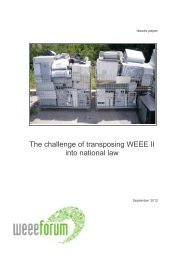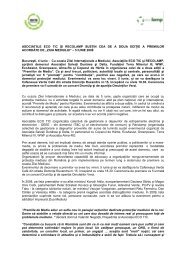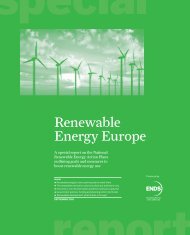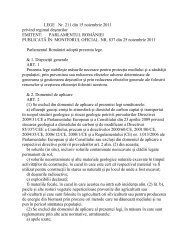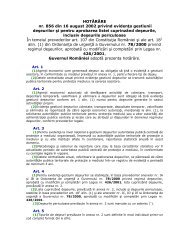PCB's in Small Capacitors from Waste Electrical and ... - Ecotic
PCB's in Small Capacitors from Waste Electrical and ... - Ecotic
PCB's in Small Capacitors from Waste Electrical and ... - Ecotic
You also want an ePaper? Increase the reach of your titles
YUMPU automatically turns print PDFs into web optimized ePapers that Google loves.
PCB’s <strong>in</strong> <strong>Small</strong> <strong>Capacitors</strong> <strong>from</strong> <strong>Waste</strong> <strong>Electrical</strong> <strong>and</strong> Electronic Equipments<br />
We may assume that the situation <strong>in</strong> Switzerl<strong>and</strong> does<br />
not differ much <strong>from</strong> that <strong>in</strong> Austria. By convert<strong>in</strong>g the<br />
total annual fl ow 2006 <strong>in</strong> Austria proportionally to the<br />
Swiss population fi gure, we reach a PCB fl ow of approx.<br />
8’500 kg/a <strong>from</strong> WEEE <strong>in</strong> Switzerl<strong>and</strong>. Compared with<br />
Swiss consumption fi gures, circumstances abroad <strong>and</strong><br />
former exam<strong>in</strong>ations, <strong>and</strong> <strong>in</strong> spite of the analytical<br />
uncerta<strong>in</strong>ties, the fl ows derived <strong>from</strong> the analyses are<br />
plausible.<br />
4.3 PCB Substitutes<br />
All matters <strong>and</strong> groups of substances identifi ed qualitatively<br />
with the screen<strong>in</strong>g methods described under paragraph<br />
3.3, are presented <strong>in</strong> Table 10. In most of the<br />
cases, larger groups of substances with a great number<br />
of <strong>in</strong>dividual matters are found, <strong>and</strong> these latter can vary<br />
considerably <strong>from</strong> each other. Interpretations must therefore<br />
be made with great reservations. As far as it is<br />
known, the substances are subdivided accord<strong>in</strong>g to<br />
their functions <strong>in</strong> capacitors <strong>and</strong> labelled with the EU<br />
Classifi cation Risk Phrases for Hazardous Substances.<br />
As a fi rst priority, the offi c ial classifi cation of hazardous<br />
matters was founded upon the Directive (1967/548/<br />
EWG). A list of the hazardous matters with their respective<br />
classifi cation is given <strong>in</strong> Annex II of the present Directive.<br />
Hazard classifi cations for substances not <strong>in</strong>cluded<br />
<strong>in</strong> this list can be found <strong>in</strong> safety data sheets <strong>from</strong><br />
manufacturers or other databases, such as the IUCLID 9<br />
Chemical Data Sheet.<br />
Table 10: Overview of identifi ed substance groups follow<strong>in</strong>g capacitor samples with the mark<strong>in</strong>g of<br />
hazardous materials<br />
Identified Substances <strong>and</strong><br />
Substance Groups<br />
Mark<strong>in</strong>g of Hazardous Materials<br />
Official<br />
Annex II 67/548/CE<br />
Electrolytes, Solvents <strong>and</strong> Other Additives<br />
Other Sources<br />
N,N, dimethylacetamide, R20/21, 36, 40, 61 X X<br />
(2-)hydroxybenzoic acid R22, 37/38, 41 X<br />
Benzyl alcohol R20, 22 X<br />
Dimethylbenzyl alcohol R22, 36/37/38 X<br />
PCB Substitutes (Dielectrics)<br />
Naphthalene R22, 40, 50/53 X X X X X<br />
Chlor<strong>in</strong>ated naphtalene<br />
R20/21/22,<br />
36/37/38<br />
X X X X X<br />
Dibutyl phtalates R40, 50, 61, 62 X X X X X X X X<br />
Diethyl phtalates X X X X X X X X<br />
Diethylhexyl phathalates R40, 60, 61 X X X X X X X X<br />
1,1-diphenyl ethan<br />
2,2’-dimethyl biphenyl<br />
Biphenyl, substituted<br />
(alkyled) biphenyls<br />
X<br />
X<br />
X X 10 X X<br />
Diverse hydrocarbons X X X X X<br />
Matters with Unknown Function<br />
(1-)methyl naphthalene R22, 36/37/38,<br />
42/43, 51/53<br />
Triphenyl phosphate R50/53 X<br />
Hexabrom-benzene<br />
1,11-dibromoundecane<br />
R20/21/22/22,<br />
36/37/38<br />
1 LHA MIxture<br />
2 Dishwashers<br />
3 SHA Mixture<br />
X<br />
4 Microwaves<br />
X<br />
5 Cool<strong>in</strong>g <strong>and</strong> freez<strong>in</strong>g<br />
appliances<br />
6 Fluorescent Tube Lamps<br />
7 IT / CE < 1 cm<br />
X<br />
8 IT / CE 1 – 2.5 cm<br />
X<br />
7 IT / CE > 2.5 cm<br />
10 UPS Systems<br />
9<br />
International Uniform Chemical Information Database<br />
10<br />
Quantitative value: 18 % referr<strong>in</strong>g to capacitor weight<br />
16



